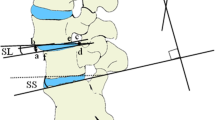Abstract
Purpose
Percutaneous cement discoplasty (PCD) is a minimally invasive surgical procedure, that can provide a segmental stabilizing and indirect decompression effect in case of severely degenerated discs characterized by vacuum phenomenon. The objective of this study was to evaluate the effects of PCD on spinopelvic radiological parameters and their associations with the clinical outcome.
Methods
Retrospective analysis of prospectively collected dataset of 28 patients (112 lumbar segments) who underwent single- or multilevel PCD was performed. Spinopelvic, intrasegmental and intersegmental parameters were measured on lumbar X-rays pre-, postoperatively and 6 months after the surgery. Correlations between radiological parameters and clinical outcome data were determined.
Results
Sacral slope significantly increased (p < .001), and pelvic tilt (p < .05) was decreased after the PCD procedure. Segmental and total lordosis (p < .05, p < .05) disc and foraminal height showed significantly increase (p < .001, p < .001) after procedure. Pain and disability (ODI) significantly decreased due to PCD. An association was found between postoperative increase in SS and improvement in ODI (r = 0.39, p < .05). The change in low back pain was correlated with segmental scoliosis correction (p < .001). Moderate correlation was detected between the increase in disc height and ODI (p < .05) as well as leg pain (p < .01).
Conclusion
PCD is an effective minimally invasive technique to treat axial pain and disability related to severe lumbar disc degeneration. Our study shows that an improvement in lumbar alignment and a significant indirect foraminal decompression could be achieved with the procedure. These changes can significantly contribute to the pain relief and increase in the patients’ functional capacity.
Graphical abstract
These slides can be retrieved under Electronic Supplementary Material.




Similar content being viewed by others
References
Shah AMKSYJ, Chan WCW, Chan D (2017) Intervertebral disc degeneration. Springer, Cham
Pfirrmann CW, Metzdorf A, Zanetti M, Hodler J, Boos N (2001) Magnetic resonance classification of lumbar intervertebral disc degeneration. Spine 26:1873–1878
Adams MA, Dolan P (2012) Intervertebral disc degeneration: evidence for two distinct phenotypes. J Anat 221:497–506. https://doi.org/10.1111/j.1469-7580.2012.01551.x
Leone A, Guglielmi G, Cassar-Pullicino VN, Bonomo L (2007) Lumbar intervertebral instability: a review. Radiology 245:62–77. https://doi.org/10.1148/radiol.2451051359
Dolan P, Luo J, Pollintine P, Landham PR, Stefanakis M, Adams MA (2013) Intervertebral disc decompression following endplate damage: implications for disc degeneration depend on spinal level and age. Spine 38:1473–1481. https://doi.org/10.1097/BRS.0b013e318290f3cc
Varga PP, Jakab G, Bors IB, Lazary A, Szoverfi Z (2015) Experiences with PMMA cement as a stand-alone intervertebral spacer: percutaneous cement discoplasty in the case of vacuum phenomenon within lumbar intervertebral discs. Der Orthopade 44(Suppl 1):S1–S7. https://doi.org/10.1007/s00132-014-3060-1
Sola C, Camino Willhuber G, Kido G, Pereira Duarte M, Bendersky M, Mereles M, Petracchi M, Gruenberg M (2018) Percutaneous cement discoplasty for the treatment of advanced degenerative disk disease in elderly patients. Eur Spine J. https://doi.org/10.1007/s00586-018-5547-7
Dindo D, Demartines N, Clavien PA (2004) Classification of surgical complications: a new proposal with evaluation in a cohort of 6336 patients and results of a survey. Ann Surg 240(2):205–213
Cicchetti DV (1994) Guidelines, criteria, and rules of thumb for evaluating normed and standardized assessment instruments in psychology. Psychol Assess 6:284–290. https://doi.org/10.1037/1040-3590.6.4.284
Ostelo RW, Deyo RA, Stratford P, Waddell G, Croft P, Von Korff M, Bouter LM, de Vet HC (2008) Interpreting change scores for pain and functional status in low back pain: towards international consensus regarding minimal important change. Spine 33:90–94. https://doi.org/10.1097/BRS.0b013e31815e3a10
Beyer F, Geier F, Bredow J, Oppermann J, Eysel P, Sobottke R (2015) Influence of spinopelvic parameters on non-operative treatment of lumbar spinal stenosis. Technol Health Care 23:871–879. https://doi.org/10.3233/THC-151032
Chapman TM Jr, Baldus CR, Lurie JD, Glassman SD, Schwab FJ, Shaffrey CI, Lafage V, Boachie-Adjei O, Kim HJ, Smith JS, Crawford CH 3rd, Lenke LG, Buchowski JM, Edwards C 2nd, Koski T, Parent S, Lewis S, Kang DG, McClendon J Jr, Metz L, Zebala LP, Kelly MP, Spratt KF, Bridwell KH (2016) Baseline patient-reported outcomes correlate weakly with radiographic parameters: a multicenter, prospective NIH adult symptomatic lumbar scoliosis study of 286 patients. Spine 41:1701–1708. https://doi.org/10.1097/BRS.0000000000001613
Eskilsson K, Sharma D, Johansson C, Hedlund R (2017) The impact of spinopelvic morphology on the short-term outcome of pedicle subtraction osteotomy in 104 patients. J Neurosurg Spine 27:74–80. https://doi.org/10.3171/2016.11.SPINE16601
Simon J, Longis PM, Passuti N (2017) Correlation between radiographic parameters and functional scores in degenerative lumbar and thoracolumbar scoliosis. Orthop Traumatol Surg Res 103:285–290. https://doi.org/10.1016/j.otsr.2016.10.021
Castellvi AE, Nienke TW, Marulanda GA, Murtagh RD, Santoni BG (2014) Indirect decompression of lumbar stenosis with transpsoas interbody cages and percutaneous posterior instrumentation. Clin Orthop Relat Res 472:1784–1791. https://doi.org/10.1007/s11999-014-3464-6
Malham GM, Parker RM, Goss B, Blecher CM (2015) Clinical results and limitations of indirect decompression in spinal stenosis with laterally implanted interbody cages: results from a prospective cohort study. European Spine J 24(Suppl 3):339–345. https://doi.org/10.1007/s00586-015-3807-3
Pereira EA, Farwana M, Lam KS (2017) Extreme lateral interbody fusion relieves symptoms of spinal stenosis and low-grade spondylolisthesis by indirect decompression in complex patients. J Clin Neurosci 35:56–61. https://doi.org/10.1016/j.jocn.2016.09.010
Endo K, Suzuki H, Tanaka H, Kang Y, Yamamoto K (2010) Sagittal spinal alignment in patients with lumbar disc herniation. European Spine J 19:435–438. https://doi.org/10.1007/s00586-009-1240-1
Funding
Aron Lazary has received research grants from the Hungarian Scientific Research Fund, Budapest, Hungary, Award number: OTKA FK123884.
Author information
Authors and Affiliations
Corresponding author
Ethics declarations
Conflict of interest
The authors declare that they have no conflict of interest.
Additional information
Publisher's Note
Springer Nature remains neutral with regard to jurisdictional claims in published maps and institutional affiliations.
Laszlo Kiss and Peter Pal Varga have equally contributed to the research.
Electronic supplementary material
Below is the link to the electronic supplementary material.
Rights and permissions
About this article
Cite this article
Kiss, L., Varga, P.P., Szoverfi, Z. et al. Indirect foraminal decompression and improvement in the lumbar alignment after percutaneous cement discoplasty. Eur Spine J 28, 1441–1447 (2019). https://doi.org/10.1007/s00586-019-05966-7
Received:
Revised:
Accepted:
Published:
Issue Date:
DOI: https://doi.org/10.1007/s00586-019-05966-7




